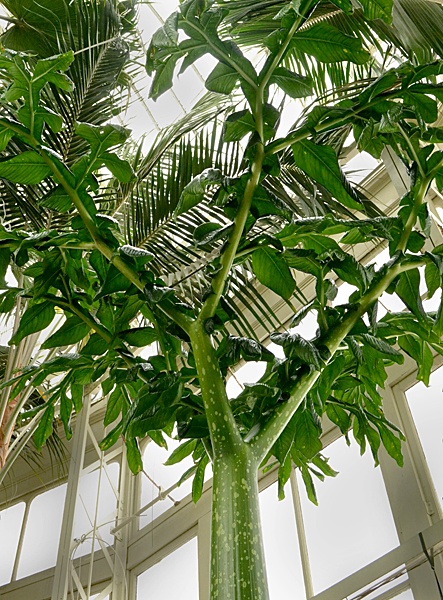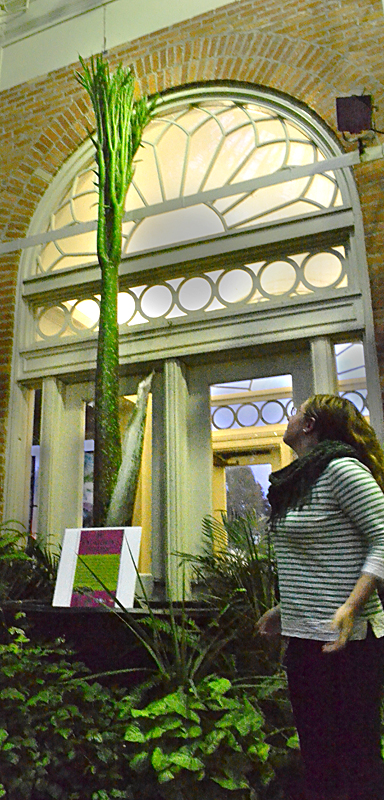
by Connie Oswald Stofko
Morty, the corpse flower or Amorphophallus titanum plant that dazzled visitors last summer when it sent up a 7 ½-foot bloom that smelled like garbage, is making a second appearance at the Buffalo and Erie County Botanical Gardens– this time as a leaf.
Morty joins two other rare Amorphophallus titanum plants that are on display at the Botanical Gardens. While all the corms (or bulbs) from which these plants grew were purchased at the same time, each plant has followed a different growth trajectory.
“This is one of the most fascinating plants I have ever grown,” said Jeff Thompson, director of horticulture at the Botanical Gardens.
The Botanical Gardens got all three corms at the beginning of July 2014.
Morty came from the largest corm, which weighed 120 pounds, and surprised everyone by blooming in just a month– the plants bloom once in 10 years or so. Visitors lined up to see and smell the plant. The corpse flower gets its name from the scent of rotting meat that it produces to attract pollinators.
After blooming, Morty went dormant, part of the normal life cycle of the plant.

Recently a sprout emerged and grew slowly for awhile. Suddenly it began to grow rapidly, as much as a foot a day. It grew straight up, looking like a stick with ruffles, but after it reached its full height, the parts that look like leaves began to droop to form an umbrella shape.
Note that what you see is not a tree, but a single leaf! The Amorphophallus titanum or corpse flower plant has the largest leaf in the world.
Morty’s leaf has reached its full height of about 12 ½ feet tall and is the tallest of the three plants on display. The stem, which looks reptilian with its speckled pattern, is three feet around.
Morty actually sent up two shoots, but the smaller one died.
“The plant sacrificed this one for the bigger one,” Thompson said.
Each Amorphophallus titanum goes through cycles over a period of years. The plant gets a leaf, then goes dormant, then gets a leaf and goes dormant again. The leaf collects energy so the plant can bloom again in the future.
About once a decade, instead of getting a leaf, it gets a flower. Does this mean we’ll have to wait another eight cycles before Morty blooms again?
Not necessarily, Thompson said.
“It could bloom after one leafing cycle,” he said. “There’s no scientific data that says it couldn’t.”
To see Morty, when you walk out of the gift shop, turn immediately to your right and you’ll see a short path. Morty is there.
The second plant, named Morticia, came from a corm weighing 80 pounds and has been on display with its leaf for a year now. When you walk out of the gift shop, turn around and face the gift shop doors. You’ll see Morticia there.
The third plant, still unnamed, came from a corm weighing 60 pounds. It has been on display with its leaf since mid-May, Thompson said.

You can help choose a name for the third plant when you visit. When you walk out of the gift shop, go to the center of the dome and turn to your right. You’ll see the unnamed plant and the box where you can drop your choice of names.
So while Morty has sent up a spectacular bloom once and has now leafed out once, each of the other two plants still has the first leaf it got after arriving at the Botanical Gardens.
How long does the plant stay in leaf? While the bloom of the Amorphophallus titanum sticks around for only a day or two, the leaf can last for months. Morticia leafed out a year ago and it still looks great.
The plant is native to Sumatra, Indonesia. In the wild, the leaf might not last as long because the plant has to deal with typhoons and rain that could beat it down and animals that could eat it.
“Ours get kind of pampered,” Thompson said.
While the plants are considered difficult to grow in conservatories, he said, the Botanical Gardens hasn’t had any trouble. He attributes it to the filtered light in the main dome.
“You might think the dome has a lot of light, but it really doesn’t,” he said. Some of the light is blocked by a chimney, and the overstory of taller plants filters the light. The dome is tall enough that the corpse flower plants don’t get close enough to touch the glass.
“That would be the kiss of death because in the freezing temperatures, the glass gets cold,” he said.

The staff also keeps the moisture at the correct levels and fertilizes the plants, though the plants don’t like to be overfertilized.
Moving the plants can be a challenge for a couple reasons. First, the plants grow so quickly. With the first two plants, the staff thought they would be able to fit the plant through the door to move it into the dome, but it had grown so much overnight that it no longer fit. They had to lean the plant on its side.
“We waited one day too long,” Thompson said.
The other problem is that the plants are so heavy. They’re placed on pallets so they can be moved with a hydraulic jack.
Morty is in a 250-gallon container, almost the size of a hot tub. It’s the largest container they could buy, Thompson said, and it cost almost as much as the corm did.
The corms were expensive, which is why not every conservatory owns these plants. However, the Botanical Gardens got three because it was such a bargain. The premier grower of corpse flowers in the world, Louis Ricciardiello, was getting out of the business, Thompson said. The Botanical Gardens got sort of a buy-one-get-two-free deal.
All of the corms are grown from seed the size of a kernel of corn, Thompson said. It takes decades to get it to a size where you can sell it. Remember, Morty’s corm weighed 120 pounds.
“That’s why these are expensive and hard to come by,” Thompson said. “Taking 10 to 20 years before you have something to sell– that’s a pretty big investment in time and labor.”
Thompson is pleased to have specimens of these exotic plants so that people can see them up close without having to travel to other parts of the world. And having three specimens increases the chances that one will bloom again sometime soon.
The Botanical Gardens is open 10 a.m. – 5 p.m. daily. Admission is $9 for adults, $8 for seniors (ages 55 and older) and students (ages 13 and older with ID), $5 for children ages 3-12 and free for Botanical Gardens members and children 2 and under.
Visitors can receive fun facts and updates on the plant on the Botanical Gardens’ Facebook page and through Morty’s Twitter Account @Mortystinks — “like” and “follow” to get regular updates. Use hashtags #corpseflower and #buffalogardens when posting.



It is great that the Botanical Garden has such unusual plants. The corm size is amazing.